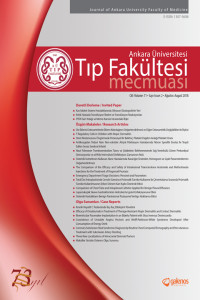Öz
Amaç: Bu çalışmanın amacı farklı orbita kitlelerinin ADC değerlerinin ortaya konması, benign ve malign kitlelerin ayrımı için eşik ADC değerinin hesaplanmasıdır.
Gereç ve Yöntem: Bu çalışma için orbita ve çevresinde yerleşimli 43 lezyonun ADC değerleri lezyonun görülebildiği her kesitte, lezyonun tümünü içerecek şekilde ölçüldü. Elde edilen ADC değerlerinin ortalaması alındı.
Bulgular: Çalışmaya dahil olan 43 hastanın yaş ortalaması: 49,3±16,6 (min-maks=17-76) olup, hastaların 26’sı (%60) kadın, 17’si (%40) erkekti. Çalışmaya 28’i benign, 15’i malign olmak üzere 43 lezyon dahil edildi. Benign lezyonların ADC değerlerinin ortalaması: 1304,8±636,2 x 10-6 mm2/s (min-maks: 423-2709 x10-6 mm2/s) olup, malign lezyonların ADC değerlerinin ortalaması: 785,6±264,1 x 10-6 mm2/s (min-maks= 420-1357x10-6 mm2/s) idi. Benign ve malign lezyonların ADC değerlerinin ortalaması arasındaki fark istatistiksel olarak anlamlıydı (p=0,006). ROC analizinde eğri altında kalan alan 0,776 (p=0,006) olarak hesaplandı. Malignite için eşik değer: 841,25x10-6 mm2/s (sensitivite: %75, spesifisite: %77) olarak bulundu. Malign lezyonların hiçbirinde kistik alan izlenmedi. Hemanjiyomların ortalama ADC değeri menenjiyomlara göre anlamlı derecede yüksek bulundu (1197,6±44,4 10-3 mm2/s vs 982,8±129,8 10-3 mm2/s; p=0.021). Lösemi ve lenfoma tutulumunda elde edilen ADC değerleri ile abselerden elde edilen ADC değerleri arasında istatistiksel olarak anlamlı fark izlenmedi (746±12,9 10-3 mm2/s vs. 452,6±29,3 10-3 mm2/s, p=0,083).
Sonuç: Orbitanın benign ve malign lezyonlarının ayrımında eşik değer literatürde tartışmalı olup, ADC değerleri çakışmaktadır. Bizim çalışmamızda elde edilen eşik değere ait sensitifite ve spesifisite değerleri de düşük bulunmuştur. Bu sebeple orbita kitleleri değerlendirilirken diffüzyon görüntüleri, klinik bulgular ve diğer görüntüleme bulguları ile korele değerlendirilmelidir
Anahtar Kelimeler
Orbita Görünür Difüzyon Katsayısı Diffüzyon Magnetik Rezonans
Etik Beyan
Etik Kurul Onayı: Çalışma için Ankara Üniversitesi Tıp Fakültesi Klinik Araştırmalar Etik Kurulundan etik kurul onayı alındı (Karar no: 03-201-19). Hasta Onayı: Retrospektif çalışma olduğundan hastalardan yazılı onam alınmadı.
Destekleyen Kurum
-
Proje Numarası
-
Teşekkür
-
Kaynakça
- 1. Razek AA, Elkhamary S, Mousa A. Differentiation between benign and maligneant orbital tumors at 3-T diffusion MR-imaging. Neuroradiology. 2011;53:517-522.
- 2. Sepahdari AR, Politi LS, Aakalu VK, et al. Diffusion-weighted imaging of orbital masses: multi-institutional data support a 2-ADC thresholdmodel to categorize lesions as benign, malignant, or indeterminate. Am J Neuroradiol. 2014;35:170-175.
- 3. Sun B, Song L, Wang X, et al. Lymphoma and inflammation in the orbit: Diagnostic performance with diffusion-weighted imaging and dynamic contrast-enhanced MRI. J Magn Reson Imaging. 2017;45:1438-1445.
- 4. Politi LS, Forghani R, Godi C, et al. Ocular adnexal lymphoma: diffusionweighted MR imaging for differential diagnosis and therapeutic monitoring. Radiology. 2010;256:565-574.
- 5. Haradome K, Haradome H, Usui Y, et al. Orbital lymphoproliferative disorders (OLPDs): value of MR imaging for differentiating orbital lymphoma from benign OPLDs. AJNR Am J Neuroradiol. 2014;35:1976-1982.
- 6. Xu XQ, Hu H, Liu H, et al. Benign and maligneant orbital lymphoproliferative disorders: differentiating using multiparametric MRI at 3.0T. J Magn Reson Imaging. 2017;45:167-176.
Öz
Objectives: The aim of this study was to determinate the ADC values of different orbital masses and to calculate the threshold ADC value for differentiation of benign and malignant masses.
Materials and Methods: For this study, ADC values of 43 lesions located in and around the orbita were measured. The obtained ADC values were averaged.
Results: The mean age of the 43 patients included in the study was 49.3±16.6 (min-max= 17-76). Twenty-six (60%) of the patients were female and 17 (40%) were male. Forty-three lesions (28 benign and 15 malignant) were included in the study. The mean ADC values of benign lesions were 1304.8±636.2x10-6 mm2/s (min-max= 423-2709 x10-6 mm2/s), and the mean ADC values of malignant lesions were 785.6±264.1x10-6 mm2/s (min-max= 420-1357x10-6 mm2/s). The difference between the mean ADC values of benign and malignant lesions was statistically significant (p=0.006). The area under the curve in the ROC analysis was 0.776 (p=0.006). The cut-off value for malignancy was 841.25x10-6 mm2/s (sensitivity: 75%, specificity: 77%). No cystic area was observed in any of the malignant lesions. The mean ADC value of hemangiomas was significantly higher than meningiomas (1197.6±44.4 10-3 mm2/s vs 982.8±129.8 10-3 mm2/s; p=0.021). There was no statistically significant difference between ADC values obtained from leukemia/lymphoma involvement and abscesses (746±12.9 10-3 mm2/s vs 452.6±29.3 10-3 mm2/s, p=0.083).Conclusion: In the literature, the threshold value in the differentiation of benign and malignant lesions of the orbita is controversial. In our study, the sensitivity and specificity values were found to be low. Therefore, diffusion images should be correlated with clinical and other imaging findings.
Anahtar Kelimeler
Orbita Apparent Diffusion Coefficient Diffusion Magnetic Resonance
Etik Beyan
-
Destekleyen Kurum
-
Proje Numarası
-
Teşekkür
-
Kaynakça
- 1. Razek AA, Elkhamary S, Mousa A. Differentiation between benign and maligneant orbital tumors at 3-T diffusion MR-imaging. Neuroradiology. 2011;53:517-522.
- 2. Sepahdari AR, Politi LS, Aakalu VK, et al. Diffusion-weighted imaging of orbital masses: multi-institutional data support a 2-ADC thresholdmodel to categorize lesions as benign, malignant, or indeterminate. Am J Neuroradiol. 2014;35:170-175.
- 3. Sun B, Song L, Wang X, et al. Lymphoma and inflammation in the orbit: Diagnostic performance with diffusion-weighted imaging and dynamic contrast-enhanced MRI. J Magn Reson Imaging. 2017;45:1438-1445.
- 4. Politi LS, Forghani R, Godi C, et al. Ocular adnexal lymphoma: diffusionweighted MR imaging for differential diagnosis and therapeutic monitoring. Radiology. 2010;256:565-574.
- 5. Haradome K, Haradome H, Usui Y, et al. Orbital lymphoproliferative disorders (OLPDs): value of MR imaging for differentiating orbital lymphoma from benign OPLDs. AJNR Am J Neuroradiol. 2014;35:1976-1982.
- 6. Xu XQ, Hu H, Liu H, et al. Benign and maligneant orbital lymphoproliferative disorders: differentiating using multiparametric MRI at 3.0T. J Magn Reson Imaging. 2017;45:167-176.
Ayrıntılar
| Birincil Dil | İngilizce |
|---|---|
| Konular | Radyoloji ve Organ Görüntüleme |
| Bölüm | Makaleler |
| Yazarlar | |
| Proje Numarası | - |
| Yayımlanma Tarihi | 2 Ekim 2019 |
| Yayımlandığı Sayı | Yıl 2019 Cilt: 72 Sayı: 2 |


